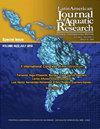哥伦比亚加勒比海阿尔伯克基岛的气候变化和小规模渔业
IF 0.8
4区 农林科学
Q3 FISHERIES
Latin American Journal of Aquatic Research
Pub Date : 2022-08-31
DOI:10.3856/vol50-issue4-fulltext-2915
引用次数: 0
摘要
从2004年到2018年,研究了阿尔伯克基群岛的气候变化与小规模渔业(SSF)之间的关系。分析的环境变量为:海面温度(SST)、风力大小和叶绿素(Chl-α)。渔业是多种多样的;共鉴定出410个个体,隶属于4目15科62种,其中珊瑚礁占38.7%,底层占35.5%,上层占25.8%。最具优势的物种是大银鱼、双棘花、海斑鱼、活鹿、秋刀鱼、atlanticus、Sphyrena barracuda、Canthidermis sufflamen、Etelis oculatus、Acanthocybium solandri、jocu鹿、Balistes vetula、海盗鹿,其次是aurorubens和Myctoperca bonaci。在生物量和商业重要性方面贡献最大的中上层物种是梭鱼、龙葵、atlanticus和双翅目E.bipinnulata,由于其高市场价值而最为重要。SST、Chl-α、风力大小和单位努力捕获量(CPUE)异常之间存在显著相关性。最高的CPUE值出现在1月、3月、6月和9月,这与冷锋和飓风的通过有关,为新的捕鱼机会和一些资源的保护让路。本文章由计算机程序翻译,如有差异,请以英文原文为准。
Climate variability and small-scale fisheries of the Albuquerque Cays Island, insular Colombian Caribbean
The relationship between climate variability and the small-scale fishery (SSF) of the Albuquerque Cays was studied from 2004 to 2018. The environmental variables analyzed were: sea surface temperature (SST), wind magnitude, and chlorophyll (Chl-α). The fishery is multi-species; 410 individuals were identified, belonging to 4 orders, 15 families, and 62 species, of which 38.7% are reef, 35.5% demersal, and 25.8% pelagic. The most dominant species were Caranx latus, Elagatis bipinnulata, Coryphaena hippurus, Lutjanus vivanus, Ocyurus chrysurus, Thunnus atlanticus, Sphyraena barracuda, Canthidermis sufflamen, Etelis oculatus, Acanthocybium solandri, Lutjanus jocu, Balistes vetula, Lutjanus buccanella, followed by Rhomboplites aurorubens and Mycteroperca bonaci. The pelagic species that contribute the most in biomass and commercial importance are S. barracuda, A. solandri, T. atlanticus, and E. bipinnulata, the most important due to their high market value. A significant correlation was found among SST, Chl-α, wind magnitude, and catch per unit effort (CPUE) anomalies. The highest CPUE values occurred in January, March, June and September were associated with the passage of cold fronts and hurricanes, giving way to new fishing opportunities and conservation of some resources.
求助全文
通过发布文献求助,成功后即可免费获取论文全文。
去求助
来源期刊

Latin American Journal of Aquatic Research
FISHERIES-MARINE & FRESHWATER BIOLOGY
CiteScore
1.70
自引率
10.00%
发文量
44
审稿时长
4-8 weeks
期刊介绍:
Latin American Journal of Aquatic Research- LAJAR is the continuation of the journal Investigaciones Marinas (1970-2007) and is published since 2008 by the Escuela de Ciencias del Mar, Facultad de Ciencias del Mar y Geografía of the Pontificia Universidad Católica de Valparaíso. LAJAR is an “Open Access” journal that publishes in English language, original research articles, reviews and short communications on aquatic science, which contain the results of research conducted in aquaculture or in oceanic and coastal marine waters of Latin America.
The following topics are considered: Physical Oceanography, Chemical Oceanography, Marine Biogeochemistry, Marine Pollution and Toxicology, Marine Geology and Geophysics, Biological Oceanography, Fisheries and Aquaculture.
 求助内容:
求助内容: 应助结果提醒方式:
应助结果提醒方式:


